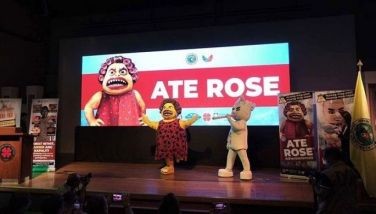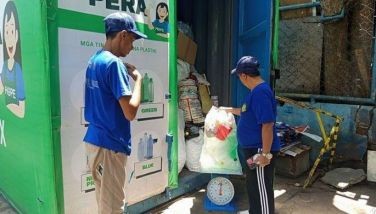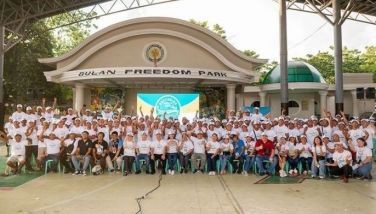Legislators feed on pork
September 7, 2004 | 12:00am
The release of "pork" is based on the lawmakers’ request to the Department of Budget and Management (DBM), detailing the nature and location of the project they want, the implementing agency, and the funds required. This setup makes legislators the lords of pork barrel funds. It also makes them natural magnets for contractors and suppliers who offer bribes so they can sell their goods and services.
No one knows exactly how much is lost to corruption in pork-funded projects. A long-time politician from the North who admits to accepting "small commissions" says that in a year, corruption in pork-barrel projects translates to about P12 billion in losses for the government.
In May 2002, Camarines Sur Rep. Rolando Andaya Jr. gave his own estimate of how much the government loses to wrongdoing. In a speech seeking to rally his colleagues’ support for the procurement reform bill, Andaya, chairman of the House appropriations committee, said P21 billion or a fifth of the government’s P104-billion procurement budget in 2001 went to the pockets of legislators, officials and contractors alone.
The amount lost is about half of the 2002 budget of the Department of Public Works and Highways (DPWH), and bigger than the budgets of state universities and colleges (P16.8 billion), the Department of Transportation and Communications (P13.3 billion), and the Department of Health (P11.8 billion).
The procurement budget includes the pork barrel of senators and congressional representatives. Going by Andaya’s estimate, about P4 billion or a fifth of the P20 billion allocated for pork this year was likely lost to corruption.
But this may be an understatement. In 1998, former finance and budget secretary Salvador Enriquez estimated that as much 45 percent of pork funds went to "commissions," particularly transactions involving medical supplies and educational materials. The kickbacks from infrastructure projects, which are traditionally more expensive, ran up to 30 percent of the total project cost, he said.
In 2001, Enriquez asserted that only about 60 percent of government funds goes to the implementation of development projects and activities. The balance lines the pockets of a "web of conspirators" that he said were "difficult to pinpoint." Following Enriquez’s estimate, the bribes paid from pork funds this year would be in the range of P8 billion of P20 billion earmarked for pork.
One veteran legislator says that congressmen tend to be more tempted to accept commissions from pork-barrel projects than senators. That’s because they have to worry about pleasing their constituents, he says.
"Contractors give me money, around five percent of the project cost, because they know I need it," says the congressman. "I don’t demand, but I accept what they give me. I need it to help my constituents. This is common practice. It will be difficult to name a colleague who does not benefit from these projects."
In 2002, Lacson spent P147 million of his P150-million pork funds for projects that included building farm-to-market roads and supplying water to some towns. At least two of those projects, however, led him to file graft cases against two members of his own staff, as well as against a DPWH regional director, a district engineer, and a municipal mayor. According to Lacson, these people made money from the transactions, which made the government lose millions of pesos in the process.
Last year, the senator announced that he was giving up his P200-million pork barrel. He not only urged his colleagues at the Senate to do the same, but also called for the abolition of pork.
By his own estimates, Lacson says only less than half of the taxpayers’ money actually goes to projects. He figures the breakdown of the kickbacks of the project proponents and implementers is something like this: 20 percent, or the lion’s share, to the legislator who identified the project; 14 percent to the contractor; 10 percent to the district engineer and other DPWH officials; five to 10 percent to the governor or mayor; two percent to the barangay captain; and two percent goes to the Commission on Audit (COA) official who is supposed to be the watchdog of the people’s money.
Even the billboards that advertise the projects and their proponents are overpriced, says Lacson.
A big-time contractor who handles public works projects of senators and congressmen confirms the continuing practice of legislators drawing kickbacks from pork. But he gives a different kickback breakdown: legislator, five to 10 percent; DPWH, five to 10 percent; DBM, one percent; COA, 0.5 percent. The contractor says the amounts have gone down slightly because the payment of VAT or valued added tax, a stipulation of the Bureau of Internal Revenue, has eaten into the usual share of legislators and DPWH personnel from pork. VAT accounts for 10 percent of the project cost.
A senator points to dredging, asphalt overlays, and farm-to-market roads as the most corruption-riddled infrastructure projects. "There is simply no way to monitor how well these are implemented," says the senator. "If they tell you they will dredge x cubic meters who will check where the hell that number of cubic meters went? The same with asphalt overlay. Whether it is one centimeter or 10 inches, nobody knows."
Another contractor adds that the public will never even know how many times a certain project has been approved for repair by how many agencies.
A COA insider confirms auditors partake of payoffs, but clarifies that the state auditing agency’s total share is bigger than many assume. "Decisions (of auditors) are really for sale," says the insider. "You have the inspector who does the after-project report and gets 0.5 percent of the pork. You have the director who gives his opinion or approves the report. And you go up the ladder. For COA, that must be about 10 percent to 15 percent of the pork all in all. It’s a small price to pay for politicians when you think of the possibility of going to court."
A 1998 PCIJ study showed that the biggest kickbacks of legislators come from the purchase of medical supplies and educational materials funded by the Countrywide Development Fund and the Congressional Initiative Allocation. With such purchases, grease money can take up from 40 to 65 percent of project cost. In comparison, commissions from infrastructure projects ranged from 12 percent to 20 percent.
Lawmakers get half of the cut as soon as the deal is struck; the balance, upon the issuance by the DBM of the Special Allotment Release Order and/or the Notice of Cash Allocation. The SARO gives the implementing agency the authority to contract goods and services, while the NCA is an assurance that funds for the project are already available in the implementing agency’s bank account.
Legislators, however, do not have a monopoly on the largesse from pork-barrel projects. One PCIJ study tracing the flow of pork, for instance, indicates that heads of implementing agencies get 10 to 12 percent of total project cost upon issuance of the SARO/NCA. Budget personnel are allotted one to two percent "to expedite the release" of funds to the implementing agency.
After the bidding and during the execution of projects by the contractors, local officials are given their share, too: seven percent to the mayor and three percent to the barangay captain, all paid after the issuance of the necessary permits.
During the Estrada administration, kickbacks from various items due to overprice, nondistribution, or cash conversion (in the case of National Food Authority or NFA rice for distribution) reached as high as 50 percent of total pork funding. A congressional staff member also recalls, "The rice subsidy was the favorite of many congressmen because they could give away just a few and then the rest they would then sell to rice traders. That became rampant until finally it was stopped because too many legislators could no longer explain where much of the rice was going."
Before the practice was halted, congressmen had poured P636.5 million of their pork into the rice subsidy programs in 2001. The amount accounted for 40 percent or the biggest share of the first tranche – amounting to P1.62 billion – of the Priority Development Assistance Fund or PDAF released that year.
But another congressional staff member says legislators found a way to go around this. Soon, the favorite pork project of wily lawmakers became funding "local government unit capability building"—which could be "almost anything," says the staff member. From 33 percent of the first tranche of the PDAF in 2001, the share of these types of projects leapt to 60 percent of the second tranche of the facility that very year.
Often, the project involved the distribution of educational materials, which, with the help of local government officials, could easily be faked. "The money could look used up even if there wasn’t anything distributed," the congressional employee says. "All you need is the cooperation of the local executive."
This scheme remains popular. But lawmakers, contractors, and government regulators talk of different percentages and parameters, and give varying justifications for the practice.
Allegations of anomalies attending pork-barrel projects have prompted the DBM to limit the funds’ use to areas that are less prone to corruption like scholarships and medical assistance. The DBM under the Arroyo administration has thus prohibited the use of pork funds to buy NFA rice, medicines, and textbooks and supplementary materials.
In 2003, Congress appended a special provision in the General Appropriations Act (GAA) allowing its members to use a maximum of 10 percent of their PDAF to procure rice and other basic commodities from the NFA. Such authority was included by President Arroyo among the items for conditional implementation in her veto message. Although spared from direct veto, the disbursement of funds to buy NFA rice required that appropriate guidelines first be drawn up.
After a brief casual meeting, negotiations for commissions are coursed through coordinators, usually the senator’s children, sibling, chief of staff, or project manager, says a contractor. Some congressmen adopt the same modus operandi.
The children of a former senator were said to be part of their father’s multimillion-peso gravy train. According to some contractors, they committed projects and accepted the commissions on behalf of the senator. One contractor recalls advancing P5 million to the ex-senator’s son for a P50-million project. When the project didn’t push through, the contractor asked for either a refund of his "earnest money" or another project. The senator’s son kept the money and the contractor was given another project.
The contractor says there are also cases where a legislator’s close aide would cut a deal for himself without his boss’ knowledge. The chief of staff of a senator known for turning down commissions, for example, once asked a contractor for a sport utility vehicle. But the aide failed to deliver the promised contract. The contractor, who had made sure the vehicle remained registered in his name, took back the P1.3-million car.
A Congress insider says some contractors are asked for commissions by the legislator’s staff who assist them. In some instances, the contractors voluntary hand the staff "tips." And sometimes the liquidation of funds is padded. The insider says a few chiefs of staff band together and share tips on how to make commissions.
Contractors say they make up for the bribes by ensuring that these are covered by the overprice in project estimates. Some contractors also ignore project specifications to ensure bigger profit margins.
Once an understanding about a project is reached, the lawmaker instructs a member of his staff to write the head of the Senate finance committee or the House appropriations committee to identify the projects. The letter is forwarded to the DBM and the implementing agency.
For public works projects, the contractor then goes to the DPWH regional director with the legislator’s letter. He proceeds to the engineering group, which prepares the specifications of the projects based on the contractor’s requirement. After this, a bidding notice is announced through the newspapers and the contractor with the legislator’s letter is expected to "win" the award.
Except for the amount of funds at the senators’ disposal, transactions involving the pork barrel of congressmen follow almost the same pattern. Unlike in the Senate, though, suppliers and contractors openly trawl the Batasan complex, especially when the SAROs and NCAs are issued. Some of them seem to feel so at home at the House that they can be seen cooling their heels in the session hall or bantering with Congress personnel.
The same suppliers and contractors also visited the congressman’s office carrying bulky bags or envelopes. Says the staffer: "You’d know right away if it was payoff time. The money would be inside an envelope or bag. Once the (supplier or contractor) came out, the envelope would be gone or the bag would suddenly look flat. And then we’d suddenly have free merienda."
BrandSpace Articles
<
>
- Latest
- Trending
Trending
Latest
Trending
Latest
Recommended
































